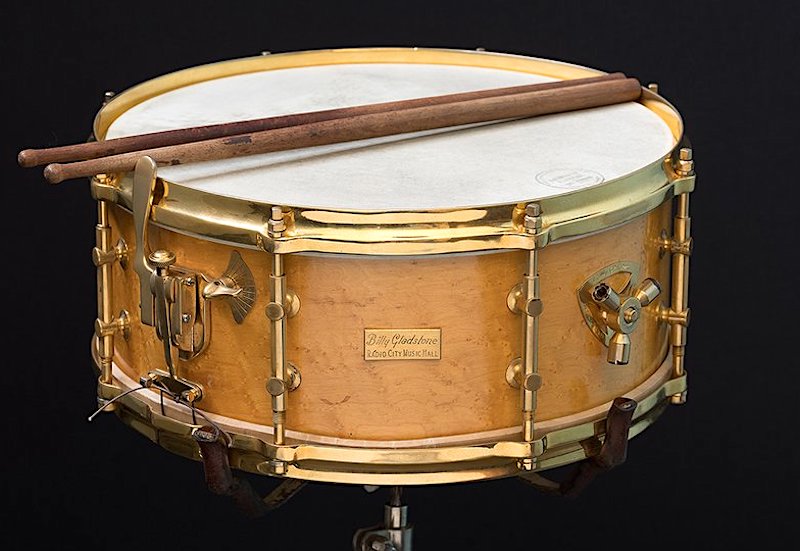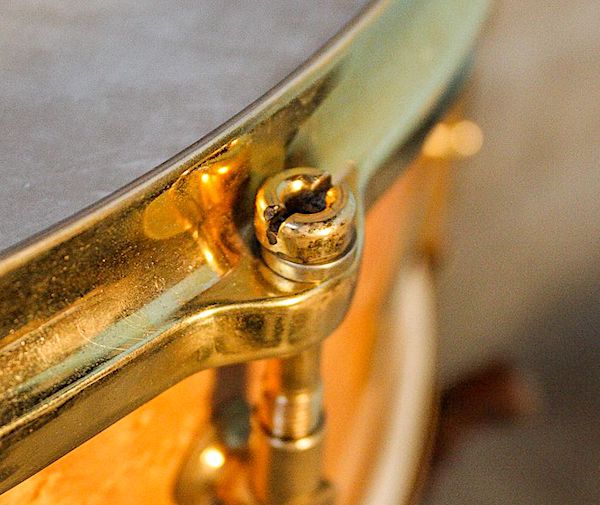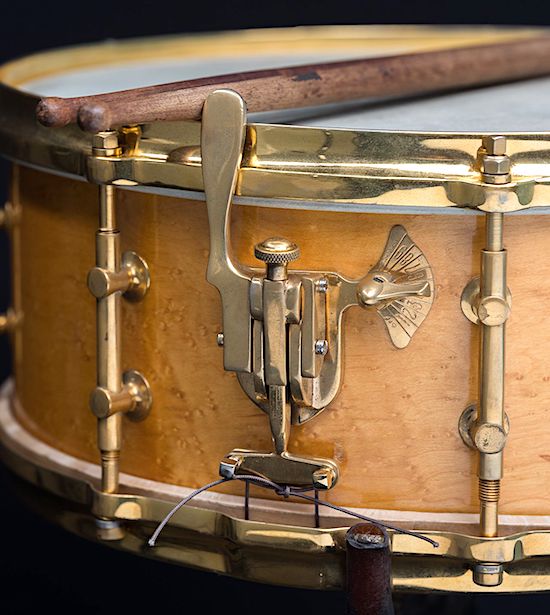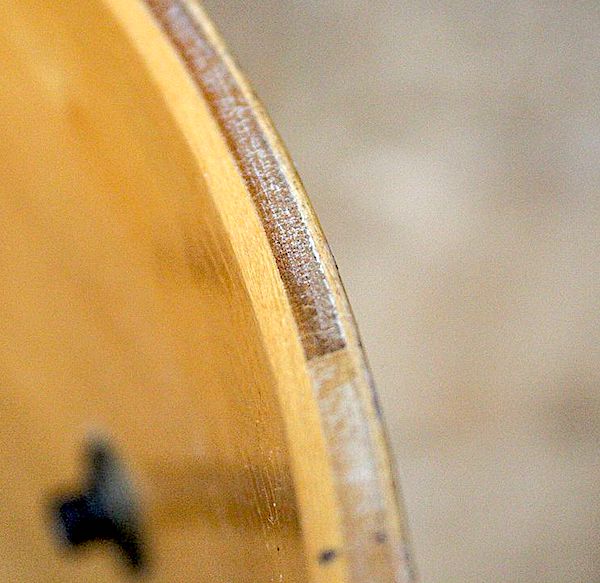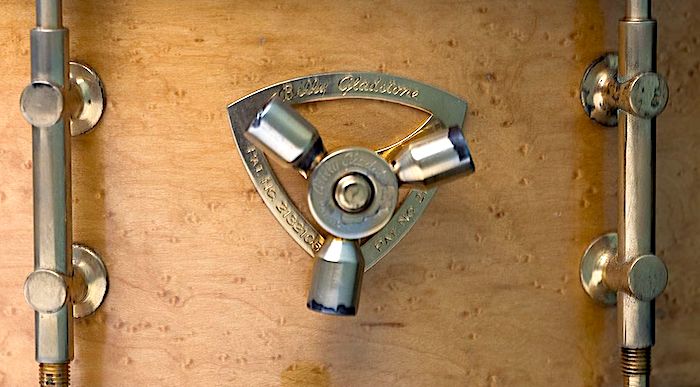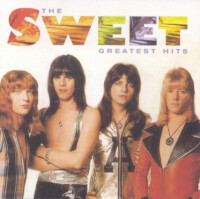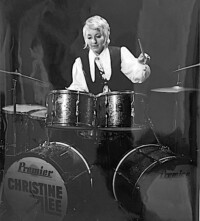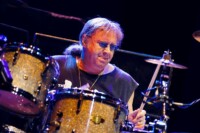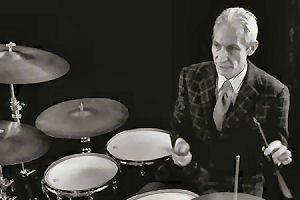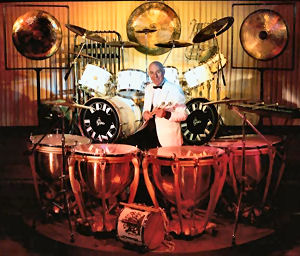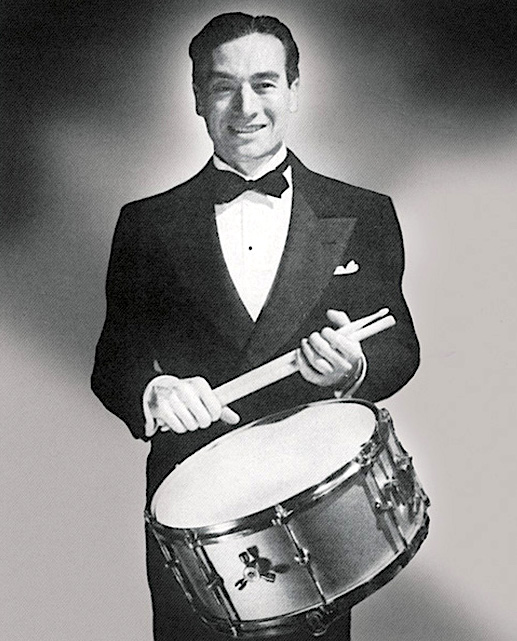 Billy Gladstone was born on December 15th, 1892 and began life in Romania as William David Goldstein. His father was English and the supervisor of Romania’s Symphony Orchestra. His musical education and playing career began on the baritone horn in his father’s orchestra but he was more interested in studying percussion – enough to make his own sticks at nine years old. He arrived in the US with his aunt when he was 11 and his name was inadvertently changed by the Immigration Officer who either misheard or misread it when he arrived at Ellis Island. He referred to him as Gladstone, a name which Billy decided he liked enough to hang on to.
Billy Gladstone was born on December 15th, 1892 and began life in Romania as William David Goldstein. His father was English and the supervisor of Romania’s Symphony Orchestra. His musical education and playing career began on the baritone horn in his father’s orchestra but he was more interested in studying percussion – enough to make his own sticks at nine years old. He arrived in the US with his aunt when he was 11 and his name was inadvertently changed by the Immigration Officer who either misheard or misread it when he arrived at Ellis Island. He referred to him as Gladstone, a name which Billy decided he liked enough to hang on to.
As a teenager he took a job at a large New York City department store simply because they had their own drum and bugle corps. Although he joined then as a bugler, the corps desperately needed drummers so Gladstone decided to try his hand at drumming. He was a quick learner who soon worked out how to play the drums and in no time became the corps’ teenage drumming star.
Eventually he began to realise his ambition to make a name for himself in New York City as a professional orchestral musician with a chap called Major Edward Bowes – who had a talent show on radio in the late twenties. Working on Broadway was always his dream of playing symphonic music. This came to fruition when his friend, conductor Erno Rapee hired him as a percussionist for his Capital Theatre Orchestra which just happened to be right there on ‘The Great White Way’. The place opened in 1919 by which time Billy Gladstone was twenty-seven.
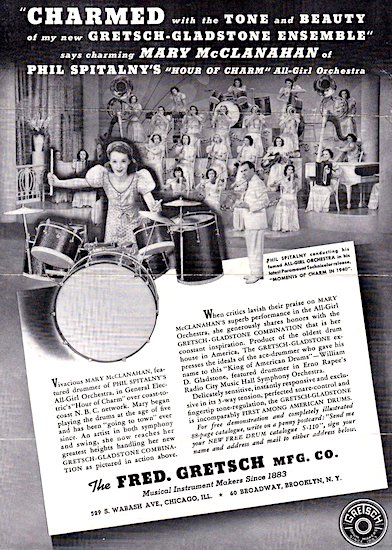 Billy Gladstone was allegedly one of Gretsch’s first endorsement superstars and not only was he one of the most respected percussionists of his era (most of his contemporaries including Buddy Rich and Louie Bellson say he was the best snare drum player who ever lived) he was also a creative inventor – he had over 20 U.S. patents with his name on them. As we will see he was also a respected instrument builder. Besides his prodigious talent on percussion, it transpires Billy was also a very fine pianist.
Billy Gladstone was allegedly one of Gretsch’s first endorsement superstars and not only was he one of the most respected percussionists of his era (most of his contemporaries including Buddy Rich and Louie Bellson say he was the best snare drum player who ever lived) he was also a creative inventor – he had over 20 U.S. patents with his name on them. As we will see he was also a respected instrument builder. Besides his prodigious talent on percussion, it transpires Billy was also a very fine pianist.
In the early 1920s Gladstone first demonstrated this talent for ‘breathing on’ drums and percussion instruments and thereby improving them. He invented a double-action bass drum pedal with a heel and toe action enabling a player to strike both the bass drum and a mounted cymbal and was awarded his first U.S. Patent for it. Not too long after this he designed and patented a collapsible snare drum stand. Gladstone’s first big break came in 1927 when he took out a patent on a hand-held mechanical cymbal playing device: the Hand Sock Cymbal. This invention caught the attention of the Leedy Drum Company who were of course drum manufacturers who were responsible for the marketing of the accessory and the cymbals and publicised his invention in their 1928 catalog. Leedy then signed Billy Gladstone to his first endorsement deal.
1932 was a very significant milestone in Billy Gladstone’s career. The legendary Radio City Music Hall opened its doors in New York City and, once again,his friend, conductor Erno Rapee, was hired as Musical Director. Rapee got together 75 of the city’s finest musicians for his orchestra and hired Gladstone to perform in the pit in front of what was described as “the most famous, elaborate, and best-equipped stage in the world”.
Before long, Gladstone became something of a legend with the Radio City Music Hall Symphony Orchestra. From his photos it’s obvious he was a dapper, flamboyant showman whom critics, drummers and music lovers alike were hugely impressed by. Comments about him were he “used high sticking and body movements to great effect” and that Gladstone was “the only musician capable of drawing attention away from the famous Radio City Music Hall Rockettes who were executing their high-kicks on stage”. As we intimated Gladstone’s amazing snare drum technique, stick-control, and sheer speed earned him recognition by his peers and fellow musicians as the world’s best snare drum player.
Radio City Music Hall quickly became Gladstone’s life and he married one of of the Rockettes. This dance troupe was one of the perennial features of any Radio City show and they attracted audiences too. I played there several times from the seventies although Billy had been dead for almost 10 years by then, but I always thought of him as I looked into the pit, or just when I walked down Broadway past the theatre on my way somewhere else.
It was 1937 when the Gretsch Company recognised Billy’s value as a musician, inventor, and high profile performer and approached him not only with an offer of an endorsement, but also the offer of a partnership for a new line of professional drums with his name on them. As we said Billy was with Leedy at the time but unsurprisingly decided to throw his lot in with Gretsch in Brooklyn. Gladstone liked Gretsch’s die cast hoops and their lightweight, but stronger 3-ply drum shells. He especially liked the lack of reinforcement rings making for a completely smooth drum inside. (NB I learned from something Steve Maxwell wrote on line that there actually were early Gladstone’s fitted with glue rings.)
That revolutionary new Gretsch-Gladstone snare drum was introduced to the trade at the 1937 Music Trade Convention in New York City and evidently caused quite a stir. Many of Gladstone’s patented inventions were featured on the new drum line including 2 and 3-way head tensioning (more of this later), as well as the no-nonsense throw-off snare control (activated by touching it with a drumstick) and fingertip damper (called a tone-regulator) which were also standard equipment on these new drums. He didn’t just invent drums though, he also invented a conductor’s baton with a light on the end which could be easily seen in the dark, and a wallet/key holder.
Of course, as I’ve just mentioned, his greatest mechanical achievement was the tuning mechanism that was on the Gretsch-Gladstone snare drum which needed a three-headed key to operate it. The key was essential to use the mechanism, so to keep it safe it screwed to the drum shell. Each of the three ‘arms’ of the key fitted over a different part of the tension bolt and loosened or tightened the top head, bottom head, or both at the same time.
It seems Billy got the idea from the roller skate-screw mechanism skaters were using at Radio City. Drum Educator Ted Reed explained how it was in the Radio City days before Billy invented his revolutionary snare drum: “Shortly before the pit went up, he’d reach in and tap the drum to check the tension. When the pit went up and 6000 people were in the theatre, the humidity would immediately affect the calfskin heads. Billy would tighten the top head but didn’t care to turn the drum upside-down in front of 6000 people to tighten the bottom.” The new invention solved the problem.
Billy was a big fan of wood shells and his opinion was that they wouldn’t put pearl on violins because it would kill the sound. He also used thin slightly oversized flesh hoops to create what George Way referred to as tympani-type seating which floated and did not touch the shell. Like George, he believed that the less that touched the shell, the better the sound would be.To do this the insides of his shells were finished just as smoothly as the outside. Just a few of his drums were covered with pearl, but he’d only do that to please a customer. His friend Ted Reed wanted one in WMP but Billy refused saying that covering was for toilet seats!
As Ludwig did with their Super-Sensitive, he used 12-strand snares which fitted into 12 corresponding holes in the strainer with set screws so that each strand could be individually adjusted. Because of the care Billy put into his drums, including the snare wires, according to Ted the drum sounded incredible. He’d tune the snares and tighten them to a certain pitch before covering them with shellac. Ted said he’d sand them with fine sandpaper when they dried, tune them again and then apply another coat of shellac. The process would continue until he was absolutely certain no moisture could penetrate the snares so they would never curl.
I wasn’t there but I’m told we should not underestimate the impact the Gretsch-Gladstone partnership had across the music industry. Professional drummers immediately understood it was something special and that it was the finest drum being manufactured in America. Despite its high cost ($100 was a month’s salary for most people in the late 1930s and it was at least twice as expensive as everybody else’s snare drums). That said, many of the best players of the time queued-up to buy one of the new Gretsch-Gladstone drums.
In addition to Gladstone playing his new drum at Radio City Music Hall, other prominent drummers began playing Billy’s like: Papa Jo Jones with Count Basie’s Band, Nick Fatool of Benny Goodman’s band and Shelly Manne from Stan Kenton’s Band. The most famous Gretsch-Gladstone endorser of the late 1930s was big band legend Chick Webb, dubbed “The King of the Drums” by his peers. Since Buddy Rich was playing that snare drum too, it’s saying a lot that Chick Webb had the highest profile.
1937-1942 were the really golden years for both Gretsch and Billy and their revolutionary line of drums. Sadly, during the four years of World War II, production of Gretsch-Gladstone drums was terminated because the metal used in them was proscribed 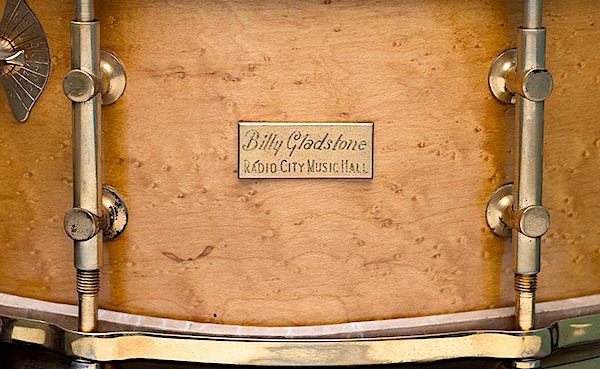 because it was needed to support the war effort. After the war, Gretsch-Gladstone production resumed but it seems the relationship was never quite the same. Gretsch discontinued the 3-way tension tuning Gladstone drum and only offered the standard 2-way drum. They also switched to using 4-ply and 6-ply shells instead of Gladstone’s favoured 3-ply shell.
because it was needed to support the war effort. After the war, Gretsch-Gladstone production resumed but it seems the relationship was never quite the same. Gretsch discontinued the 3-way tension tuning Gladstone drum and only offered the standard 2-way drum. They also switched to using 4-ply and 6-ply shells instead of Gladstone’s favoured 3-ply shell.
Although Gretsch had abandoned the 3-way tuning drum after the war, Gladstone still believed there was a market for it and Gretsch’s superior drum shells and die cast hoops. So in 1949 Billy Gladstone began making the drums himself in his New York apartment with just a little help from a friend, using parts supplied by Gretsch – die cast hoops and 3-ply shells.
Gladstone’s custom drum business became his passion during the 1950s and focused attention away from several personal difficulties including the death of his wife Dorothy and the ending of his long-standing job with the Radio City Music Hall Orchestra.
Word quickly spread about the quality of Gladstone’s own custom snare drums and many of the top drummers of the 1950s including Gene Krupa, Buddy Rich, Sticks McDonald, Louie Bellson, and Stanley Koor placed orders and played their Gladstone snare drums on stage and in recording studios.
Throughout the 1950s and early 1960s, Gladstone split his time between his custom drum business and being an orchestra percussionist for several Broadway musicals including My Fair Lady. He was on the road with the show in 1957 and it transpired that drummers, who were coming from miles around, ended up just concentrating intently on Billy and so had to go again if they wanted to see the show.
Besides the guys we’ve already spoken of, Viola Smith was once a proud owner of one of his snare drums, as was Charles Cordes (who helped Billy build them in his New York apartment), Ed Wiebold, Shelly Manne and of course Louie Bellson.
There weren’t too many Gladstone snares produced and he only made fifty of them along with just a half-dozen complete sets. Every now and again we’ll see a snare drum for sale. The most expensive I’ve seen was $27,000 dollars so most of us will not be able to buy one with anything other than a platinum (or black) credit card. A guy once brought one into my shop in the late seventies to be rejuvenated which we did. Unfortunately he came back for it when I wasn’t there so I wasn’t able to make him an offer for it he couldn’t refuse. This was in the seventies when vintage drum collecting was in its infancy – so neither me, nor anybody else would have been offering thousands!
Buddy Rich was a fan who loved to hear Billy play Ravel’s Bolero and said every stroke was like an arrow which could almost shatter your eardrum. Buddy was once the proud owner of one of the snare drums which Billy presented to him. Barrett Deems who played with Louis Armstrong and is mentioned in Satchmo’s song “Now You Has Jazz” in the film “High Society” (“now you has mister Barrett Deems”).admired him greatly too and is on record saying he felt his rolls were so fabulous they “sounded like sand pouring out of a pitcher”.
Billy Gladstone had a phenomenal technique which was based on the action of the hammers on a piano. His fingers were very much part this technique and his philosophy was that arms and wrists were simply not enough to accomplish what he wanted to achieve.
Some say the circular rubber practice pad which was also offered by Ludwig and Billy Hyde was one of his very best ideas and it’s certainly lasted a long time. When it was placed on a snare drum, a star-shaped hole under the centre of the pad would create a vacuum. It could not be lifted from the drum, only peeled off. You can of course still get it today.
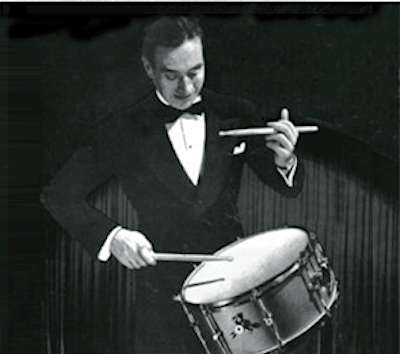 Gretsch say: “The legacy of Billy Gladstone continues to build today and Gretsch will fortunately be forever linked to this unique musical genius, master drummer, and inventor. The quality and innovation of Gretsch-Gladstone drums and Gladstone’s custom snare drums have stood the test of time for over 70 years and are among the most-prized and collectable vintage drums in the world today”.
Gretsch say: “The legacy of Billy Gladstone continues to build today and Gretsch will fortunately be forever linked to this unique musical genius, master drummer, and inventor. The quality and innovation of Gretsch-Gladstone drums and Gladstone’s custom snare drums have stood the test of time for over 70 years and are among the most-prized and collectable vintage drums in the world today”.
Unfortunately it was discovered Billy Gladstone had cancer during a routine operation in August 1961 and he died several months later at the age of 68.
Bob Henrit
February 2019
*Special thanks to Doug Sole at Soul Drums (www.souldrums.com) in Toronto for the kind use of the photos of the amazing original Gladstone snare. For more information about the drum, please get in contact with them directly.
Thank you Doug!

